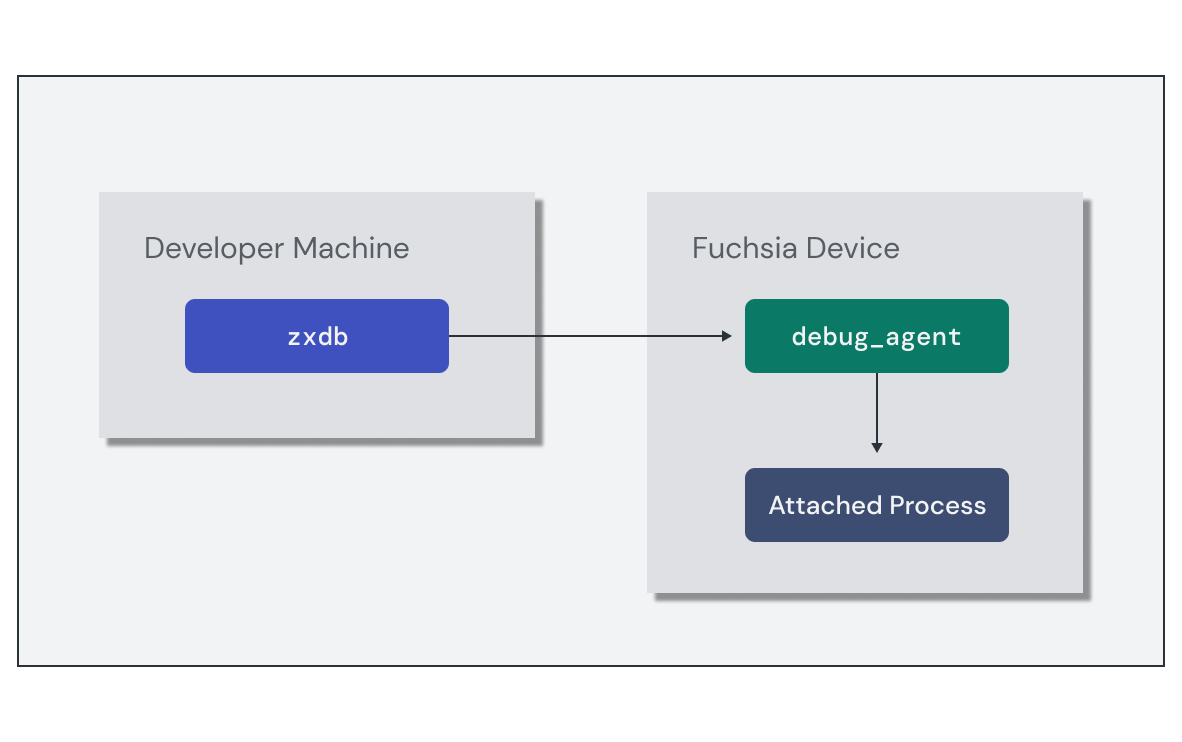开发软件意味着处理程序崩溃问题并找出 bug 的根源。Fuchsia 提供了一套工具,可帮助您从分析崩溃日志到在核心代码中进行完整的逐步调试,识别和诊断组件中的问题。
分析崩溃问题
Fuchsia 会在启动时启动一个名为 crashanalyzer 的程序,该程序会报告程序崩溃并将崩溃线程的回溯输出到系统日志。虽然您可以通过在运行时查看日志来直接探索这些信息,但回溯内容是使用堆栈内存地址引用编码的,而不是指向程序源文件中的相应行。
[klog][I] devmgr: crash_analyzer_listener: analyzing exception type 0x108
[klog][I] <== fatal exception: process crasher[42410] thread initial-thread[42424]
[klog][I] <== fatal page fault, PC at 0x1e1888dbbbd7
[klog][I] CS: 0 RIP: 0x1e1888dbbbd7 EFL: 0x10246 CR2: 0
[klog][I] RAX: 0 RBX: 0x1 RCX: 0x721ad98697c6 RDX: 0x77accb36f264
[klog][I] RSI: 0 RDI: 0 RBP: 0x2781c4816f90 RSP: 0x2781c4816f80
[klog][I] R8: 0 R9: 0 R10: 0 R11: 0x246
[klog][I] R12: 0x773bf11dcda0 R13: 0x773bf11dcdd0 R14: 0x16 R15: 0x78050d69
[klog][I] errc: 0x6
[klog][I] bottom of user stack:
[klog][I] 0x00002781c4816f80: f11dcda0 0000773b 9ccd2b38 000039b2 |....;w..8+...9..|
[klog][I] 0x00002781c4816f90: c4816fd0 00002781 88dbbba7 00001e18 |.o...'..........|
[klog][I] 0x00002781c4816fa0: 00000008 00000000 9ccd2b38 000039b2 |........8+...9..|
[klog][I] 0x00002781c4816fb0: f11dcf70 0000773b f11dcf70 0000773b |p...;w..p...;w..|
[klog][I] 0x00002781c4816fc0: cb36f570 000077ac f11dcdd0 0000773b |p.6..w......;w..|
[klog][I] 0x00002781c4816fd0: c4816ff0 00002781 cb2b0d0f 000077ac |.o...'....+..w..|
[klog][I] 0x00002781c4816fe0: 00000054 00000000 f11dcf70 0000773b |T.......p...;w..|
[klog][I] 0x00002781c4816ff0: f11dcfe0 0000773b 00000000 00000000 |....;w..........|
[klog][I] arch: x86_64
[klog][I] dso: id=a94c78564173530d51670b6586b1aa471e004f06 base=0x7d3506a49000 name=libfdio.so
[klog][I] dso: id=a61961ba9776a67a00fb322af9ebbdcfd1ce3f62 base=0x77accb297000 name=libc.so
[klog][I] dso: id=760f1e6e47d3dd8b6a19150aa47241279ec75a9c base=0x721ad9863000 name=<vDSO>
[klog][I] dso: id=b18462140c6784a53736105bbf3021852eeda68c base=0x1e1888dbb000 name=app:crasher
[klog][I] bt#01: pc 0x1e1888dbbbd7 sp 0x2781c4816f80 (app:crasher,0xbd7)
[klog][I] bt#02: pc 0x1e1888dbbba7 sp 0x2781c4816fa0 (app:crasher,0xba7)
[klog][I] bt#03: pc 0x77accb2b0d0f sp 0x2781c4816fe0 (libc.so,0x19d0f)
[klog][I] bt#04: pc 0 sp 0x2781c4817000
[klog][I] bt#05: end
这是因为默认情况下,调试符号会在构建时从核心二进制文件中剥离。如需正确分析崩溃日志,您需要将这些符号重新应用于回溯,以便按源代码行号查看调用堆栈。当您调用 ffx log 命令时,开发者工具会通过名为 symbolizer 的额外二进制文件处理原始日志,该文件会将本地 build 配置中的符号重新应用于日志中的任何回溯。
ffx log您看到的输出包含重新应用于回溯的符号:
[klog][I] devmgr: crash_analyzer_listener: analyzing exception type 0x108
... same output as "raw" backtrace ...
start of symbolized stack:
[klog][I] #01: blind_write at ../../src/developer/forensics/crasher/cpp/crasher.c:21
[klog][I] #02: main at ../../src/developer/forensics/crasher/cpp/crasher.c:137
[klog][I] #03: start_main at ../../zircon/third_party/ulib/musl/src/env/__libc_start_main.c:49
[klog][I] #04: unknown, can't find pc, sp or app/library in line
end of symbolized stack
通过正确符号化的回溯,您可以直接发现源代码中的崩溃位置。
逐行调试
仅知道程序崩溃的位置可能不足以全面诊断问题。有时,您需要逐步浏览代码,甚至检查内存中变量的状态。为此,Fuchsia 提供了一个名为 zxdb 的核心代码调试程序。
zxdb 工具是一个客户端,用于连接到目标设备上正在运行的 debug_agent 组件。您可以使用 zxdb 命令将 debug_agent 配置为附加到特定进程并设置断点。将调试会话附加到正在运行的进程后,您可以使用 zxdb 逐步调试代码并检查堆栈帧。

设置调试会话需要完成以下高级步骤:
- 在目标设备上运行
debug_agent组件。 - 运行
zxdb客户端并连接到目标设备。 - 设置
zxdb的位置以查找调试符号。
启动调试会话的最简单方法是使用 ffx debug connect 命令,该命令会在本地 Fuchsia build 的上下文中执行所有这些操作。不过,如果您需要单独配置这些步骤,也可以手动执行这些步骤。
调试会话处于活动状态后,您会进入 [zxdb] 提示,以便发出调试程序命令。您可以使用 zxdb 配置 debug_agent,以便使用名称过滤器附加到进程并设置待处理的断点,即使当前没有任何匹配的进程正在运行也是如此。
以下示例在 main 上设置一个待处理断点,以便在执行开始时停止,并等待名为“hello-world”的进程启动:
[zxdb] attach hello-world
Waiting for process matching "hello-world"
[zxdb] break main
Breakpoint 1 (Software) on Global, Enabled, stop=All, @ main
Pending: No matches for location, it will be pending library loads.
将调试程序附加到进程后,您可以使用 zxdb 命令来控制和检查进程的状态。下面列出了一些常用命令:
step
|
在线程中单步跳过下一行代码 |
next
|
进入线程中的下一行代码 |
continue
|
继续执行,直至下一个断点、异常或退出 |
frame
|
列出当前堆栈帧或从中进行选择 |
print
|
评估表达式并输出结果 |
练习:使用 Fuchsia 调试程序
在本练习中,您将使用 Fuchsia 调试程序 (zxdb) 检查 echo-args 组件的正在运行的实例,并了解崩溃的原因。
启动模拟器
如果您还没有运行的实例,请启动模拟器:
启动新的模拟器实例:
ffx emu start --headless启动完成后,模拟器会输出以下消息并返回:
Logging to "$HOME/.local/share/Fuchsia/ffx/emu/instances/fuchsia-emulator/emulator.log" Waiting for Fuchsia to start (up to 60 seconds)........ Emulator is ready.启动软件包服务器,以便模拟器加载软件包:
fx serve
启动调试会话
模拟器启动后,使用 ffx debug connect 命令启动 zxdb 调试会话:
ffx debug connectConnecting (use "disconnect" to cancel)...
Connected successfully.
👉 To get started, try "status" or "help".
[zxdb]
成功连接后,zxdb 提示符便可接受命令。
附加到组件
在启动组件之前,请将 zxdb 配置为附加到 echo-args 的实例。这样,调试程序便会在进程启动后立即附加:
[zxdb] attach echo-args
在 greeting() 函数上设置断点:
[zxdb] break greeting
调试程序准备就绪后,启动新的 echo-args 组件实例:
ffx component run /core/ffx-laboratory:echo-args fuchsia-pkg://fuchsia.com/echo-args#meta/echo-args.cm探索调试会话
到达 greeting() 中的断点后,执行会停止,调试程序会等待新命令。使用 list 命令显示当前执行暂停的位置:
Rust
[zxdb] list
18
19 // Return a proper greeting for the list
20 fn greeting(names: &Vec<String>) -> String {
21 // Join the list of names based on length
▶ 22 match names.len() {
23 0 => String::from("Nobody"),
24 1 => names.join(""),
25 2 => names.join(" and "),
26 _ => names.join(", "),
27 }
28 }
29
C++
[zxdb] list
17
18 // Return a proper greeting for the list
▶ 19 std::string greeting(std::vector<std::string>& names) {
20 // Join the list of names based on length
21 auto number_of_names = names.size();
22 switch (number_of_names) {
23 case 0:
24 return "Nobody!";
25 case 1:
26 return join(names, "");
27 case 2:
28 return join(names, " and ");
29 default:
print 命令将输出当前堆栈帧中的所有变量的状态。打印 names 的当前值:
Rust
[zxdb] print names vec!["Alice", "Bob", "Spot"]
C++
[zxdb] print names {"Alice", "Bob", "Spot"}
使用 next 命令逐步调试 greeting() 函数几次:
[zxdb] next
如需让程序继续运行至完成,请使用 continue 命令:
[zxdb] continue
退出调试会话以返回终端:
[zxdb] exit
引入一些会崩溃的代码
接下来,您将向 src/main.rs 添加一些代码,以导致该组件崩溃(或 panic)。如需模拟此行为,请在收集实参后立即添加 assert!(false) 宏:
Rust
echo-args/src/main.rs:
#[fuchsia::main(logging = true)]
async fn main() -> Result<(), anyhow::Error> {
// ...
// Simulate a crash
assert!(false, "fake crash");
// Print a greeting to syslog
info!("Hello, {}!", greeting(&args));
Ok(())
}
C++
echo-args/main.cc:
int main(int argc, const char* argv[], char* envp[]) {
// ...
// Simulate a crash
std::strlen(nullptr);
// Print a greeting to syslog
FX_LOGS(INFO) << "Hello, " << echo::greeting(arguments) << "!" << std::endl;
return 0;
}
再次运行 fx build 以重新构建组件:
fx build使用 zxdb 启动新的调试会话:
ffx debug connect调试崩溃的堆栈帧
将调试程序配置为附加到 echo-args 组件:
[zxdb] attach echo-args
启动组件的新实例:
ffx component run /core/ffx-laboratory:echo-args fuchsia-pkg://fuchsia.com/echo-args#meta/echo-args.cm这次,调试程序检测到抛出了异常。使用 frame 命令检查崩溃时刻的堆栈轨迹:
Rust
[zxdb] frame
▶ 0 abort() • abort.c:7
1 panic_abort::__rust_start_panic::abort() • panic_abort/src/lib.rs:43
2 panic_abort::__rust_start_panic(…) • panic_abort/src/lib.rs:38
3 std::panicking::rust_panic(…) • library/std/src/panicking.rs:672
4 std::panicking::rust_panic_with_hook(…) • library/std/src/panicking.rs:642
5 std::panicking::begin_panic::$({closure#0}<&str>)() • rust/library/std/src/panicking.rs:544
6 std::sys_common::backtrace::$(__rust_end_short_backtrace<std::panicking::begin_panic::{closure#0}, !>)(…) • rust/library/std/src/sys_common/backtrace.rs:144
7 std::panicking::begin_panic<…>(…) • rust/library/std/src/panicking.rs:543
8 echo_args::main::component_entry_point::$({generator#0})(…) • main.rs:18
9 core::future::from_generator::$({impl#1})::$(poll<echo_args::main::component_entry_point::{generator#0}>)(…) • rust/library/core/src/future/mod.rs:80
10 core::future::future::$({impl#1})::$(poll<&mut core::future::from_generator::GenFuture<echo_args::main::component_entry_point::{generator#0}>>)(…) • future/future.rs:119
11 futures_util::future::future::FutureExt::$(poll_unpin<core::pin::Pin<&mut core::future::from_generator::GenFuture<echo_args::main::component_entry_point::{generator#0}>>>)(…) • future/future/mod.rs:562
12 fuchsia_async::runtime::fuchsia::executor::local::MainTask::$(poll<core::pin::Pin<&mut core::future::from_generator::GenFuture<echo_args::main::component_entry_point::{generator#0}>>>)(…) • fuchsia/src/lib/fuchsia-async/src/runtime/fuchsia/executor/local.rs:444
13 fuchsia_async::runtime::fuchsia::executor::local::LocalExecutor::$(run_singlethreaded<core::future::from_generator::GenFuture<echo_args::main::component_entry_point::{generator#0}>>)(…) • fuchsia/src/lib/fuchsia-async/src/runtime/fuchsia/executor/local.rs:73
14 fuchsia::$(main_singlethreaded<fuchsia::init_logging_for_component_with_executor::{closure#0}, core::future::from_generator::GenFuture<echo_args::main::component_entry_point::{generator#0}>, core::result::Result<(), anyhow::Error>>)(…) • fuchsia/src/lib/fuchsia/src/lib.rs:152
15 echo_args::main() • main.rs:7
16 core::ops::function::FnOnce::call_once<…>(…) • /b/s/w/ir/x/w/rust/library/core/src/ops/function.rs:227
17 std::sys_common::backtrace::__rust_begin_short_backtrace<…>(…) • rust/library/std/src/sys_common/backtrace.rs:125
18 std::rt::lang_start::$({closure#0}<core::result::Result<(), anyhow::Error>>)() • rust/library/std/src/rt.rs:63
19 core::ops::function::impls::$({impl#2})::call_once<…>(…) • /b/s/w/ir/x/w/rust/library/core/src/ops/function.rs:259 (inline)
20 std::panicking::try::do_call<…>(…) • library/std/src/panicking.rs:403 (inline)
21 std::panicking::try<…>(…) • library/std/src/panicking.rs:367 (inline)
22 std::panic::catch_unwind<…>(…) • library/std/src/panic.rs:129 (inline)
23 std::rt::lang_start_internal::$({closure#2})() • library/std/src/rt.rs:45 (inline)
24 std::panicking::try::$(do_call<std::rt::lang_start_internal::{closure#2}, isize>)(…) • library/std/src/panicking.rs:403 (inline)
25 std::panicking::$(try<isize, std::rt::lang_start_internal::{closure#2}>)(…) • library/std/src/panicking.rs:367 (inline)
26 std::panic::$(catch_unwind<std::rt::lang_start_internal::{closure#2}, isize>)(…) • library/std/src/panic.rs:129 (inline)
27 std::rt::lang_start_internal(…) • library/std/src/rt.rs:45
28 std::rt::lang_start<…>(…) • rust/library/std/src/rt.rs:62
29 $elf(main) + 0x1f
30 «libc startup» (-r expands)
31 «libc startup» (-r expands)
32 $elf(_start) + 0x11
请注意,堆栈轨迹中的第 8 行表示 src/main.rs 中发生崩溃的位置,对应于 assert!() 宏代码行。
C++
[zxdb] frame
▶ 0 strlen(…) • strlen.c:21
1 main(…) • main.cc:27
2 «libc startup» (-r expands)
3 «libc startup» (-r expands)
4 $elf(_start) + 0x11
请注意,堆栈轨迹中的第 1 行表示 main.cc 中发生崩溃的位置,对应于 nullptr 引用。
当前堆栈帧(帧 0)位于系统库深处,但您可以通过在命令前面附加堆栈轨迹中的帧编号来检查任何堆栈帧。
通过传递帧编号,输出崩溃时参数的值,如下所示:
Rust
[zxdb] frame 8 print args vec!["Alice", "Bob", "Spot"]
C++
[zxdb] frame 1 print arguments {"Alice", "Bob", "Spot"}
退出调试会话以返回终端:
[zxdb] exit
销毁实例
使用以下命令清理 echo-args 实例:
ffx component destroy /core/ffx-laboratory:echo-args
